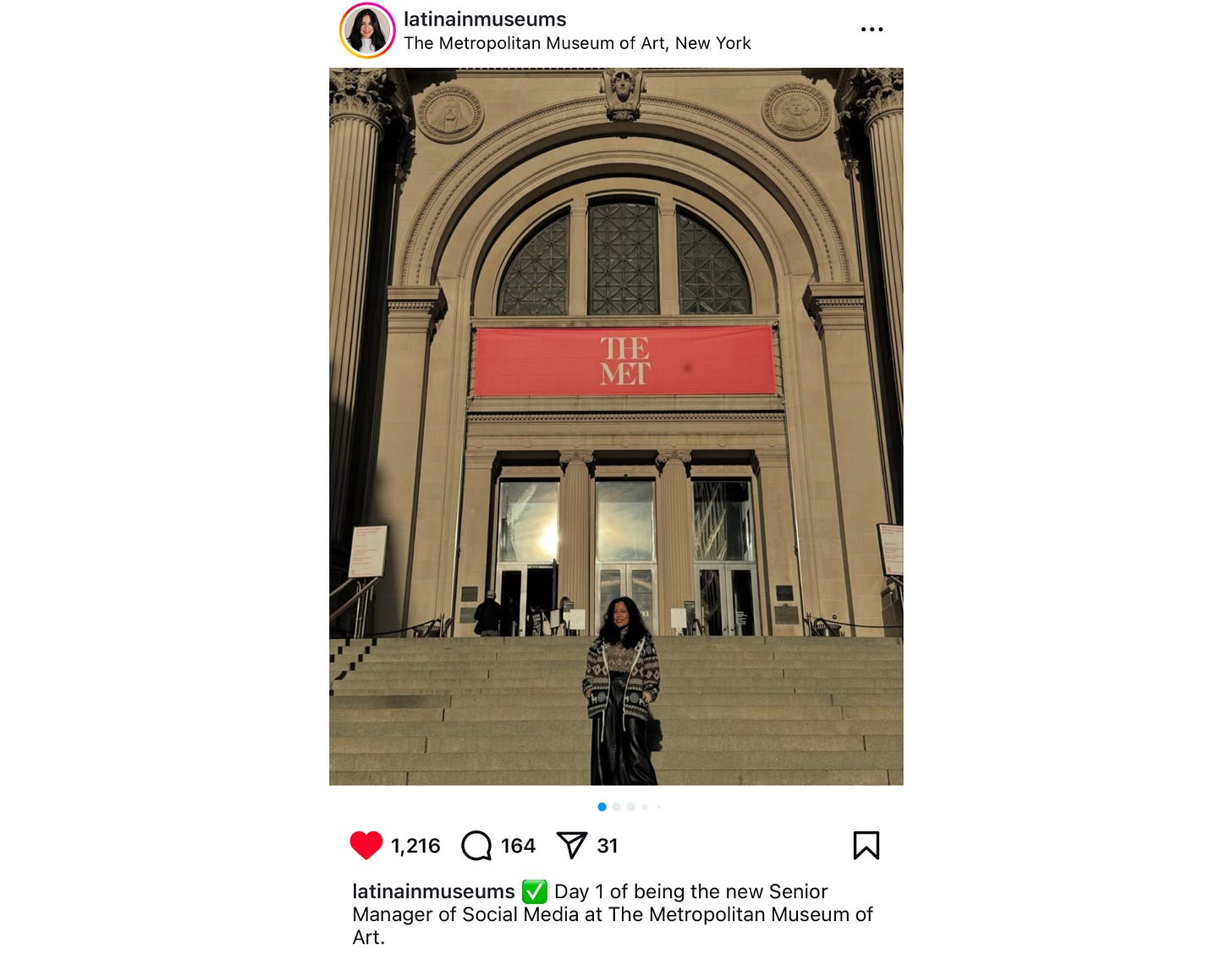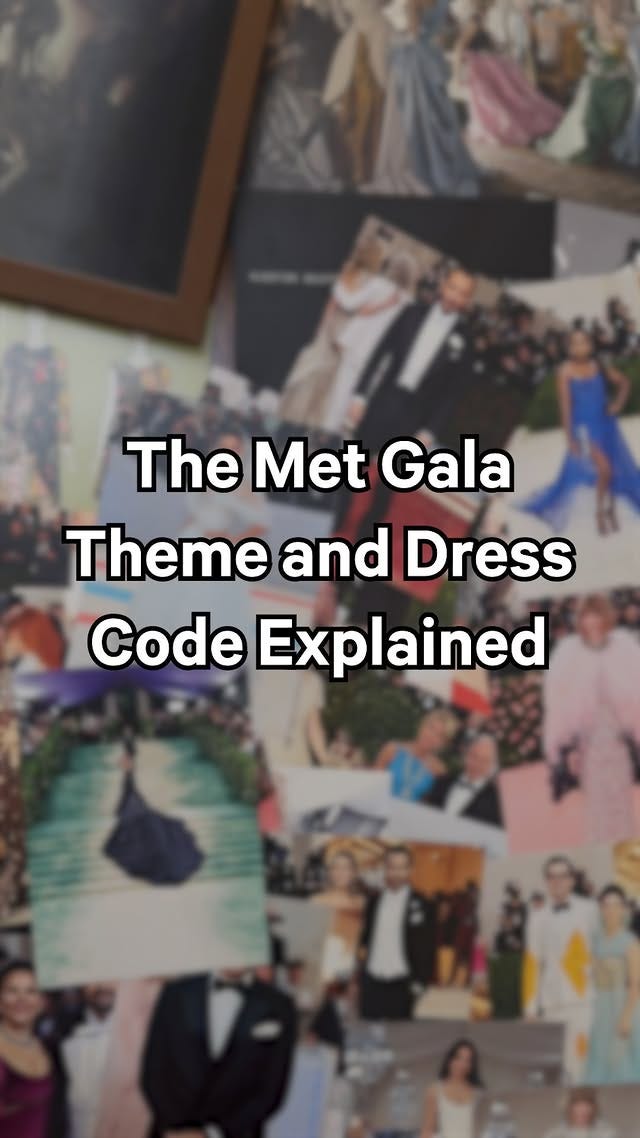Her Office Is One of the Most Iconic Museums in the World
I talk to Karen Vidangos about working in social at The Met and running her personal account 'Latina in Museums'.
A question that I often get is: Do I need a personal social presence to work in social media?
The answer is complicated. We spend so much of our professional lives online, that I’d never say that it’s required. It really isn’t. At the same time, it can have benefits. For today’s newsletter I am chatting with someone whose personal social presence has helped her find jobs, set expectations in roles, and build community.
Karen Vidangos is the Senior Manager of Social Media at The Metropolitan Museum of Art and also posts under her own account Latina in Museums. She started the account because she didn’t see people who looked like her reflected in museum spaces online. Since the first post, she’s been using her account to explore and elevate underrepresented perspectives in the arts. She now has over 8,000 followers and has worked at places like the National Portrait Gallery, the Guggenheim Museum, and currently The Met.
In today’s newsletter I talk to Karen about using social media as a tool for visibility, bringing personal beliefs to brand accounts, and why you should give your audience what they don’t yet know they want. As Karen tells me in our conversation, “For me, social media is a powerful tool to amplify voices and perspectives that have historically been overlooked, creating a more inclusive and representative narrative.”
Sponsored by Dash Social
How Brands Can Leverage Creators
Did you know creator partnerships fuel growth for brands by driving engagement up 13% on Instagram and 46% on TikTok?
We all know in our gut the impact working with creators can have on a brand—but it’s hard to find numbers that support it. That’s why Dash Social’s latest Social Media Trends Report is so helpful. Stats like the above are exactly what help us social professionals get buy-in and sell through big ideas. Other interesting pieces of data from the report include:
On TikTok, creator content achieves over 10x more shares on average than brand content
Creators achieve a 3.5% engagement rate vs. brands’ 0.3%
Reels make up 61% of creator posts and 51% of brand posts
One of my favorite parts of the report is the brand case studies, where we hear how BÉIS and Crumbl leverage creators. This report is for any brand wanting to work more creator content into their strategies in 2025.
Rachel Karten: First, can you tell me about your current role and any previous social (or not!) roles you've had?
Karen Vidangos: I am the Senior Manager of Social Media at The Metropolitan Museum of Art. I’ve spent nearly a decade managing social media for museums, including Glenstone Museum, the National Portrait Gallery, and the Guggenheim Museum. Each role has deepened my understanding of how to use social platforms to connect audiences with art and cultural storytelling.
RK: What do you love about doing social media in the art world?
KV: What’s not to love? My office is in one of the most iconic museums in the world! My job is to share beautiful and meaningful artworks with a global audience, from Van Gogh to Mark Bradford. Every day, I collaborate with my social media team to find innovative and engaging ways to connect people with art, taking them on an art-filled journey with us. It’s incredibly rewarding to create content that not only showcases the museum’s treasures but also fosters a deeper appreciation for the power of art.
RK: You've talked about starting your personal account Latina in Museums because you didn’t see people who looked like yourself reflected in museum spaces online. How do you think about using social media as a tool for visibility?
KV: The Latine community is one of the highest demographic groups using social media as a key communication tool within their community. For me, social media is a powerful way to lower barriers to access in a field where art workers of color are significantly underrepresented.
My personal account, Latina in Museums, offers an honest look at my journey—the work I’ve done, how I’ve done it, and the challenges I’ve faced along the way. By sharing my experiences, I hope to inspire others in my community to see what we’re capable of achieving in this space. Hearing from people who’ve thanked me for speaking openly about these topics is incredibly humbling. I may be just one voice in the museum field, but I’m grateful that my work has had an impact, even if it’s reached just one person.
RK: I'm curious how this might apply to brands. I've felt in some roles that it's almost impossible for me to not bring myself into the brand social presence. In what ways have you brought your personal brand to the museum accounts you've worked on?
KV: My personal brand naturally intersects with my work because museums have been undergoing a reckoning in recent years, acknowledging the need to better represent art workers and artists of color. In my role, I’ve thought deeply about the kind of art we feature and highlight. There are so many deserving artists in our collections, and it’s our responsibility to share their stories—ensuring they are recognized for their contributions. By amplifying these voices, we not only celebrate the richness of our collection but also help shape a more inclusive and representative future for museums.
Art history has long reflected systemic imbalances, and as a result, museum collections overwhelmingly feature works by white, male artists. This disparity trickles down to social media, where the content we have access to often mirrors those gaps. Every department—from acquisitions to curatorial to social media—plays a role in addressing this inequity. For me, social media is a powerful tool to amplify voices and perspectives that have historically been overlooked, creating a more inclusive and representative narrative.
RK: I want to talk a bit about having a personal brand and working in social media. Do you feel like it has helped when applying for jobs? Any ways it may have hindered?
KV: To my knowledge, having a personal brand has certainly helped me. If it has ever hurt, I wouldn’t necessarily know—but looking back at my career, I’ve been unapologetic about where I stand and how I represent myself. I’ve been very public about my beliefs, not just on social media but also when speaking on panels or in interviews like this one.
I’ve had the privilege of working for renowned institutions while showing up as my genuine self, and that’s something I’m incredibly proud of. That said, I recognize that this approach isn’t for everyone, and I think that’s perfectly okay. It was a chance I chose to take, knowing it could have backfired. For me, the opportunity to use the most visible and wide-reaching tool we have—social media—to address persistent issues in the arts and advocate for my community outweighed the risks. It’s a decision I stand by.
RK: Something you and I have talked about before is that a personal brand can almost set expectations up front when in the job search process. Has it helped you more easily advocate for ideas once in a position?
KV: It has definitely helped. A strong personal brand sets expectation up front, which means my perspective is already part of the conversation when I join a new role. That said, the most crucial tool I bring to the table is data, and I’ve found that it’s the key to advocating successfully. While it’s an ethical imperative to be inclusive of all communities, I can also make a compelling case for it from a sustainability standpoint.
Museums must reflect and engage with the increasingly diverse communities they serve. Without creating inviting and inclusive spaces, museums cannot sustainably thrive in the future. Social media plays a vital role in this effort—it signals to audiences that they are seen and welcome. When you engage with diverse communities online, it often translates into deeper in-person engagement. They want to be involved, included, and represented.
In the museum field, this is a challenge we’re actively grappling with, so when someone like me—a Latina who understands both the issues and the solutions, at least in the context of social media—advocates for these ideas, people tend to listen.
RK: How would you describe your social media philosophy?
KV: My social media philosophy is to give the audience what they don’t yet know they want. Not everyone has stepped inside a museum, and some may never have the chance to visit New York and experience The Met in person. They might assume The Met is only about historical works (no offense to Peter Paul Rubens!), but social media allows us to show them so much more—Mexican prints, Sienese paintings, and countless other stories waiting to be discovered.
The key is to meet audiences where they are, presenting a myriad of meaningful art that invites them to pause, reflect, and connect. In a time when the internet often feels so angry and chaotic, we have the opportunity to provide a moment of respite—a window into beauty, creativity, and humanity.
RK: What's a recent post you worked on for The Met that you're proud of?
KV: I can actually tell you about a future post I’m really excited about! My team and I are currently working on creating content to support The Costume Institute’s spring exhibition, Superfine: Tailoring Black Style. The show presents such a powerful opportunity to spotlight a history that’s often overlooked and I’m committed to supporting it in the best way I can.
RK: I think all social managers should probably take some time to log off and go to a museum. How does looking at art make you a better creative?
KV: Artists draw their creativity from all kinds of sources—whether it's religion, the environment, or their personal journey. This diversity of inspiration gives us a wide range of art, from classical to modern. Walking through a museum, you can feel that diversity—you're drawn to it, inspired by it. The colors, the gestures, the meaning; it all gives you a moment to pause, to refocus. Taking a mental break from the outside world and immersing yourself in the quiet power of art not only offers peace but also restores your creativity.
Thank you for reading! Shout out to Tori in the Link in Bio Discord for suggesting I chat with Karen for the newsletter.
You can support free interviews like this one with a paid Link in Bio subscription!
It’s likely an educational expense at your company—here’s a template for you to use when asking your manager. I personally think the Discord is worth the subscription alone.














finally, a fellow GW alum i can actually like!!!